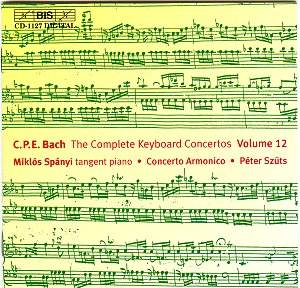Additional recordings by Miklós Spányi and Péter
Szüts
Harpsichord Concertos in c, H441; d, H427; F, H443. Hungaroton
HCD 31159
Harpsichord Concertos Volumes 1 - 11 BIS 707/8,767/8,785/6,857,867/8,914,1097
Certainly I will never forget my introduction
to this music, in the form of H 427. The University of Southern
California student orchestra was conducted from the cembalo
continuo by Ingolf Dahl, the cembalo concertato was
played by Ronald Ratcliffe, and from the first notes I was utterly
transported. I had been completely unaware that such magnificent
music existed from the pen of C.P.E. Bach, and my feelings were
so intensely aroused that I remember visualising the harpsichord
as a boat borne upon the waves of violin bows as on a raging ocean.
Naturally I immediately bought what LP recordings there were,
and over the years there have been several of H. 427. Recordings
available at the time of other concerti by C.P.E. Bach were usually
disappointingly thin and uncommitted, but I also bought them anyway.
We are finally discovering what Mozart, Haydn,
and Burney all told us: that C.P.E. Bach was a major composer.
I believe that eventually his operas will become as popular as
his keyboard concerti.
As it turns out I am familiar with this entire
set of concerti to date, and it is a whole planet of delights
and amazing discoveries. The variety of the works is at once delightful
and suspicious, for they cannot all actually be original works
by C.P.E. Bach. At least one (H.414) is surely by Johann Sebastian,
an otherwise lost secular cantata sinfonia with trumpets and drums
and clavier obbligato, possibly remembered by C.P.E. and
written out as a keyboard concerto. Others could be arrangements
of works by contemporaries and relatives ó remember that much
of the miscellaneous Bach family music went up with the Dresden
Library. Also, most of C.P.E. Bachís concertos for other instruments
end up as part of this set arranged for keyboard.
The tangent piano uses a hard brass wedge as
a hammer, and sounds much like a piano with tacks driven into
the faces of the hammers ó what we used in my youth to play baroque
music on until we could afford our own real harpsichords. The
sound closely matches a harpsichord and blends as well with the
strings. Most listeners would just assume it is a slightly odd
harpsichord.
This series of the complete harpsichord concerti
of C.P.E. Bach is one of the most important and monumental recording
projects of the century so far. For the future (if we have one)
one sees these works competing in popularity with the piano concerti
of Mozart, and this first complete recording is of such extreme
quality both in performance and recording that it will surely
remain the standard for decades to come. If you are the sort of
collector who has several complete sets of the Mozart Piano concerti,
then you will want to run out and buy this complete set of (so
far) thirteen (!) full price (!) CDs. You will never regret doing
so.
For the rest of us ó well, the d minor keyboard
concerto bears a similar relationship to C.P.E. Bachís whole set
of concerti that Mozartís d minor piano concerto, K 466, bears
to Mozartís whole set of piano concerti, in that both works in
d minor are the most dramatic, perhaps the most romantic, certainly
the most immediately accessible of the set. Therefore, if you
arenít to ready to plunge and instead want to get just one foot
wet at a time, you will want to buy the Hungaroton disk listed
above. It contains the insuperable H. 427 and was evidently the
spark that ignited this whole series. With nearly forty concerti
already recorded and evidently more to come there is plenty of
space to mix metaphors in the amazing variety of moods and sounds.
Some of the works in this series are not called
"concerto" but "sonatina" instead. These latter
works are in two movements and are often more reflective in nature,
but feature a cembalo concertato accompanied by an orchestra
and are concerti in the modern sense of the term. Some of them
could probably be played by solo instruments and would thus constitute
keyboard quintets or sextets, but the one on this disk, H.456,
is clearly orchestral in concept, with brass and winds, both movements
in rondo form, and the first movement is one of the most delightful
and original in the entire series.
But you might reasonably object: If theyíve already
made eleven volumes of this music, arenít they scraping the bottom
of the barrel in terms of musical quality? Are the performers
getting tired? The answer to both questions is an unqualified
NO. If this were the first and only CD in the series it would
still deserve all the praise Iíve given. Both H.456 and H.423
are among the better of the works in the series, wholly deserving
of the concentration and energy put into performing them. If you
come across this volume by itself on special sale in a shop, or
if you are searching for an appropriate gift for a collector who
might or might not have some of the earlier CDs in the series,
this disk is in every way worthy ó exceptional ó on its own.
Paul Shoemaker
